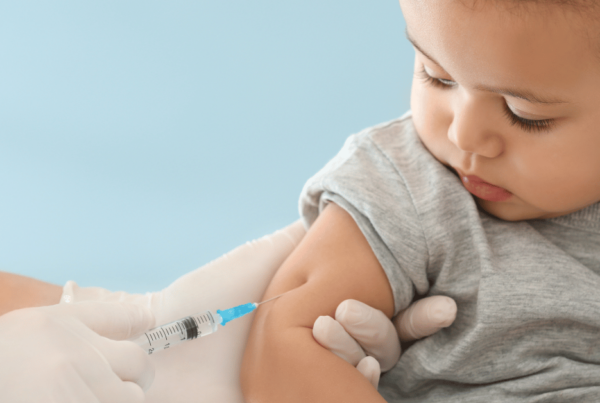As of January 30, 2015 there have been 102 confirmed cases of measles in the U.S. spanning across 14 states. It’s apparent that nobody is 100% safe from contracting measles, whether vaccinated or not. Measles cases have been reported in both parties. This article won’t go into placing more blame on one side versus the other. Let’s just make this about treating measles, should you know someone who becomes infected.
Measles Symptoms
Measles is generally a benign illness resulting in bed rest for several days with cold symptoms; runny nose and cough, a fever, a rash, and possibly white (koplik) spots in the mouth.
The Mayo Clinic has a full list of symptoms:
Measles signs and symptoms appear 10 to 14 days after exposure to the virus. Signs and symptoms of measles typically include:
- Fever
- Dry cough
- Runny nose
- Sore throat
- Inflamed eyes (conjunctivitis)
- Tiny white spots with bluish-white centers on a red background found inside the mouth on the inner lining of the cheek — also called Koplik’s spots
- A skin rash made up of large, flat blotches that often flow into one another
The infection occurs in sequential stages over a period of two to three weeks.
Infection and incubation
For the first 10 to 14 days after you’re infected, the measles virus incubates. You have no signs or symptoms of measles during this time.
Nonspecific signs and symptoms
Measles typically begins with a mild to moderate fever, often accompanied by a persistent cough, runny nose, inflamed eyes (conjunctivitis) and sore throat. This relatively mild illness may last two or three days.
Acute illness and rash
The rash consists of small red spots, some of which are slightly raised. Spots and bumps in tight clusters give the skin a splotchy red appearance. The face breaks out first, particularly behind the ears and along the hairline.Over the next few days, the rash spreads down the arms and trunk, then over the thighs, lower legs and feet. At the same time, fever rises sharply, often as high as 104 to 105.8 F (40 to 41 C). The measles rash gradually recedes, fading first from the face and last from the thighs and feet.
Communicable period
A person with measles can spread the virus to others for about eight days, starting four days before the rash appears and ending when the rash has been present for four days.
Measles (and MMR) Complications
As with any disease, there are complications with measles: dehydration, diarrhea, pneumonia, encephalitis, eye complications, and death.
According to the CDC, there are 3 populations where the above complications of measles usually arise (I’ve also provided direct quotes from the CDC below):
- Children under 5 years of age.
- Adults 20 years of age and older.
- Malnourished children.
“Complications of measles are more common among children younger than 5 years of age and adults 20 years of age and older.”
“The most common causes of death are pneumonia in children and acute encephalitis in adults.”
“Measles is more severe in malnourished children, particularly those with vitamin A deficiency.”
Children under 5 years of age:
According to the CDC, children are to receive the first dose of the MMR vaccine at age 12 months. Supposedly, this dose will confer protection against measles and those vaccinated will be “out of the measles complications woods.”
What about children under 12 months of age?
I mentioned here that breastfeeding your infant allows natural maternal antibody transfer, keeping them protected from measles for up to one year. Unfortunately, since the introduction of the MMR vaccine, mothers who have been vaccinated for measles as opposed to acquiring the infection naturally, have less antibody transfer from breast milk to protect their vulnerable infant. The CDC says it better:
“The mothers of many infants who developed measles were young, and their measles immunity was most often due to vaccination rather than infection with wild virus. As a result, a smaller amount of antibody was transferred across the placenta to the fetus, compared with antibody transfer from mothers who had higher antibody titers resulting from wild-virus infection. The lower quantity of antibody resulted in immunity that waned more rapidly, making infants susceptible at a younger age than in the past.”
Result
Due to the introduction of the MMR vaccine, Mother Nature no longer has the ability to effectively protect the young infant during this critical period when measles complications are highest.
Adults 20 years of age and older:
As with chickenpox, measles gets complicated in adults, and symptoms more severe. Here’s where it gets interesting. We all know that acquiring wild measles confers lifelong immunity, however receiving the vaccine does not necessarily do this. Since the introduction of the MMR vaccine, measles rates among adults have skyrocketed. According to the CDC:
“Relative to earlier decades, an increased proportion of cases (measles) now occur among adults. In 1973, persons 20 years of age and older accounted for only about 3% of cases. In 1994, adults accounted for 24% of cases, and in 2001, for 48% of all reported cases.”
Result
Another Mother Nature snafu.
Lastly, malnourished children
“Malnourished children” are at risk for measles complications and this came directly from the CDC, but I left out a small part. I left out “malnourished children…..in developing countries.” I did this because unfortunately there are malnourished children in the U.S. also. Measles especially affects children with a vitamin A deficiency. Complications for these children include “diarrhea, dehydration, stomatitis, inability to feed, and bacterial infections (skin and elsewhere).”
Due to strong risk factors for disease, this is the population of individuals that I’d recommend receive the MMR vaccine (just my small professional opinion).
If you choose to vaccinate or re-vaccinate, I invite you to read 5 Points for Successful Vaccination, an article completely backed by science to maximize vaccine effectiveness.
Effective Measles Treatment
We’ve covered quickly the symptoms and complications of measles. Now let’s get to the real reason for reading this piece!
Measles is a virus, so we can’t treat it with antibiotics. It’s our immune system’s job to launch the attack and capture the foreign invader. In order to lessen the measles symptoms (and complications) and effectively restore balance in the body, we must give our immune system the ammunition needed to accomplish this task.
Think of treating measles in the same manner we would treat the flu: stimulate the immune system to do its job effectively.
1. Don’t panic.
You got this.
2. Dose with vitamin A.
There are copious studies on the effectiveness of vitamin A as treatment for measles. Vitamin A has long been termed the “anti-infective” vitamin based on the increased number of infections noted in vitamin A deficiency. [1]
There was a study done at Harvard that looked at 28,573 children from Sudan between the ages of 6 months and 6 years. Vitamin A intake was strongly correlated with decreased risk of diarrhea, cough, fever, and measles. [2] This is important to reduce the risk of complications that can be associated with measles.
Vitamin A also up-regulates immune system activity and stimulates antibody response. [3,4]
“The effects on morbidity from measles are related to enhanced antibody production and lymphocyte proliferation. Benefits for severe diarrhea could be attributable to the functions of vitamin A in sustaining the integrity of mucosal epithelia in the gut..” [5]
Dosage recommendations of vitamin A set forth by the World Health Organization, as measles treatment is this:
“A high dose of vitamin A is given immediately on diagnosis and repeated the next day. The recommended age-specific daily doses are 50 000 IU for infants aged <6 months, 100 000 IU for infants aged 6–11 months, and 200 000 IU for children aged ≥12 months.” [6]
Alternatively, vitamin A can be dosed:
- age 6 months- 1 year: 100,00IU in one dose, followed by 100,000IU 4 weeks later
- >1 year old: 200,000IU in one dose, followed by 200,000IU, 4 weeks later [7]
My recommendations for reputable brands of Vitamin A:**
- Genestra A-mulsion (liquid)
- Davinci Labs
- Vital Nutrients
**I only recommend pharmaceutical grade supplements.
3. Rest.
Encourage bed rest and lounging around (at home of course). Our body recovers at a much faster rate when we give it rest. This may be a good time to offer lazy days and cartoons.
4. Hydrate.
Measles equals fever. Yes, unfortunately there will be a fever involved and possibly diarrhea. It is extremely important to stay hydrated with water and an electrolyte replacement (breast milk for babes). Stay away from “electrolyte drinks” like Gatorade or powerade (probably pedialyte also) because they are loaded with sugar and will decrease immune response (see #6). You can make your own electrolyte drink.
Make sure urine remains almost clear and little to no smell. If you should notice very yellow smelly urine, it is a sure sign of concentrated urine, dehydration.
5. Withhold fever reducing medication (the best you can).
Dr. Mendelsohn says it best: “Fevers occur due to a spontaneous release of pyrogens that cause the body temperature to rise. This is a natural defense mechanism that our bodies employ to fight disease. The presence of fever tells you that the repair defense mechanisms of the body have gone into high gear.”
Tepid compresses seem to work well during fever, as well as chamomile baths.
I’m a mother and I totally understand the helplessness we feel when our children are ill. Fevers can be scary, but generally think in terms of symptoms, not so much the thermometer. Keep checking on the overall appearance, behavior, and attitude of your sick one. Mild to moderate lethargy is normal. Breathing difficulties, vomiting, or severe lethargy are signs of complication and need treated right away.
6. Avoid Sugar.
Research shows the immune system cannot properly do it’s job in the presence of sugar:
“The decrease in phagocytic index was rapid following the ingestion of simple carbohydrates. The greatest effects occurred between 1 and 2 hr postprandial, but the values were still significantly below the fasting control values 5 hr after feeding..” [8]
7. Nourish the body with nutrient rich foods.
Typically we think of chicken soup when fighting viruses such as the flu, or in this case, measles. The most nutrient rich food that comes to my mind is homemade bone broth! It’s super easy to make and easy to digest. Here’s an amazing article by Living Whole on the beneficial properties of bone broth: Why You Should Start Drinking Bone Broth. And if you’re looking for a recipe, this is the one I use: The Healthy Home Economist: Traditional Stocks and Soups. Also, think fruits, vegetables, and porridges.
8. Antiviral herbs and herbs to stimulate the immune system.
My favorite antiviral herb is echinacea. Dr. Aviva Romm, MD recommends 1 drop of echinacea per 2 pounds of body weight, four to six times a day until strength returns. Gradually decrease the dosage and frequency of echinacea until you are giving 1 drop per 5 pounds of body weight twice a day. [9]
The immune system stimulant herb, astragalus, can be dosed 10-30 drops, 2-3 times per day also.
My recommendations for reputable brands of echinacea and astragalus:
- Herb Pharm (carries an alcohol free echinacea)
- Gaia Herbs
- Wise Woman Herbals
**I only recommend pharmaceutical grade supplements.
9. Homeopathic remedy options.
Remember with homeopathic remedies, the patient doesn’t necessarily need to have all the symptoms under the remedy, pick the remedy that fits his case the best.
Aconitum
Useful at the beginning stages of measles. child has high fever, dry barking cough, pink eye. skin burns and itches. he feels restless, anxious, and frightened. he tosses and turns.
Apis
The rash begins but fails to develop fully, then soon disappears- though child doesn’t feel completely well. the itching is made worse by warmth, and the face and eyelids are puffy.
Belladonna
Useful at the beginning stages of measles where there is sudden onset of high fever, a reddened face, and throbbing headache. tends to be drowsy, a little delirious, and has difficulty falling or staying asleep. despite fever, he is not very thirsty.
Bryonia
Skin eruptions from measles are delayed. hard, dry cough with no expectoration. any motion causes pain. he may experience some mild delirium.
Euphrasia
Fever and rash present. acrid tears and a bland nasal discharge. sensitive to light. cough but only during the day.
Gelsemium
Onset of symptoms is slow. fever present. great weakness and a sense of heaviness, both of the whole body and specifically the eyelids. there is no thirst.
Kali bic
There is ropy, stringy discharge present from the nose and burning, tearing eyes. salivary glands are noticeably swollen and may have stitching pains that go from the ear into the head and neck.
Pulsatilla
Mild case of the measles; fevers are not high. symptoms are not too painful. will have profuse tearing from the eyes and considerable nasal discharge. dry cough at night which becomes loose in the daytime. may have ear inflammation. although he has dry mouth, he isn’t thirsty.
Sulphur
Has purplish appearance. itching is aggravated by scratching. reddened mucus membranes and is very thirsty. cough and diarrhea are at their worst in the morning.
10. When to seek medical care.
- If you feel uncomfortable caring for your loved one.
- The child is very young.
- If high fever persists after rash has fully appeared.
- If chest pain develops.
- Breathing difficulty.
- Severe cough.
- Seizures or severe headaches.
- Loss of consciousness.
- Delerium.
- Stiff neck.
- Severe earache that does not respond to treatment.
I hope this helps to ease a bit of the current measles scare. If you should have any questions or comments, I’d love to hear from you below!
(Disclaimer: Scientific information presented in this article is for educational purposes only and does not constitute medical advice.)
Resources:
Biochemistry of Vitamin A and Carotenoids
Fawzi WW, Herrera MG, Willett WC, Nestel P, el Amin A, Mohamed KA. Dietary vitamin A intake and the incidence of diarrhea and respiratory infection among Sudanese children. Department of Nutrition, Harvard School of Public Health, Boston, MA 02115, USA. The Journal of Nutrition [1995, 125(5):1211-1221]
Mora JR, Iwata M, von Andrian UH. Vitamin effects on the immune system: vitamins A and D take centre stage. Nature reviews. Immunology2008;8(9):685-698. doi:10.1038/nri2378.
Ross AC, Chen Q, Ma Y. Vitamin A and Retinoic Acid in the Regulation of B-Cell Development and Antibody Production. Vitamins and hormones2011;86:103-126. doi:10.1016/B978-0-12-386960-9.00005-8.
Villamor E1, Fawzi WW. Effects of vitamin a supplementation on immune responses and correlation with clinical outcomes. Clin Microbiol Rev. 2005 Jul;18(3):446-64.
WHO Position Paper: Measles. 2009.
J Skowron, NMD. Fundamentals of Naturopathic Pediatrics. CCNM Press. 2009. 194-95.
Albert Sanchez, et al. Role of sugars in human neutrophilic phagocytosis. Am J Clin Nutr November 1973 vol. 26 no. 11 1180-1184.
Romm MD, Aviva. Naturally Healthy Babies and Children: A Commonsense Guide to Herbal Remedies, Nutrition, and Health.
Ullman MPH, Dana. Homeopathic Medicine for Children and Infants








